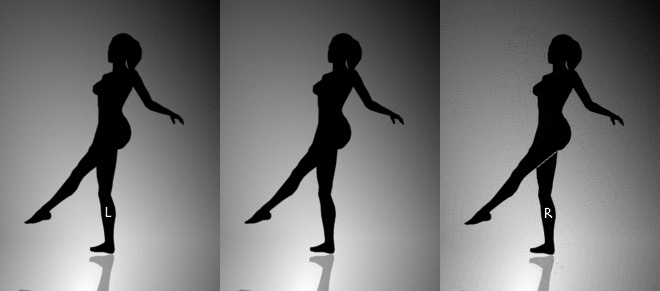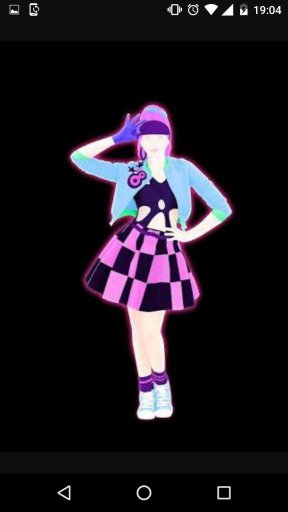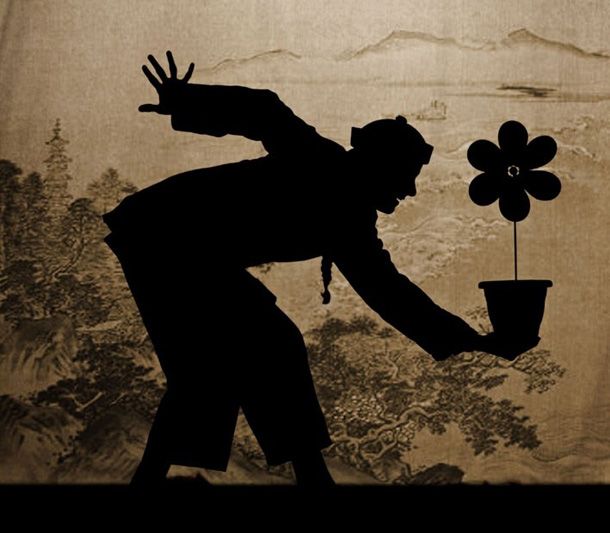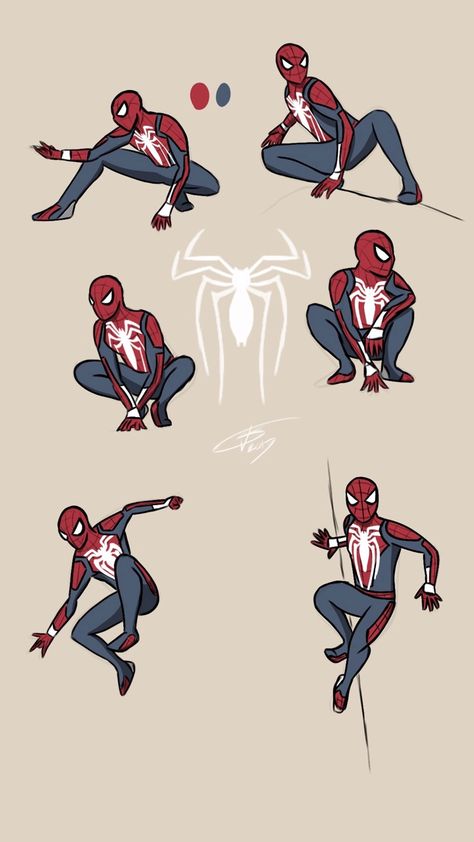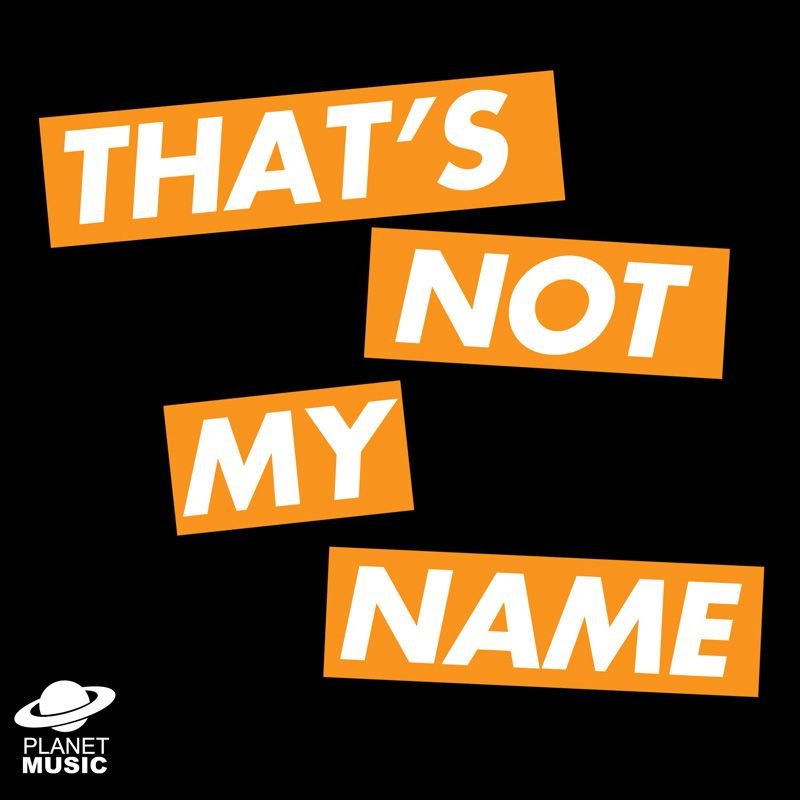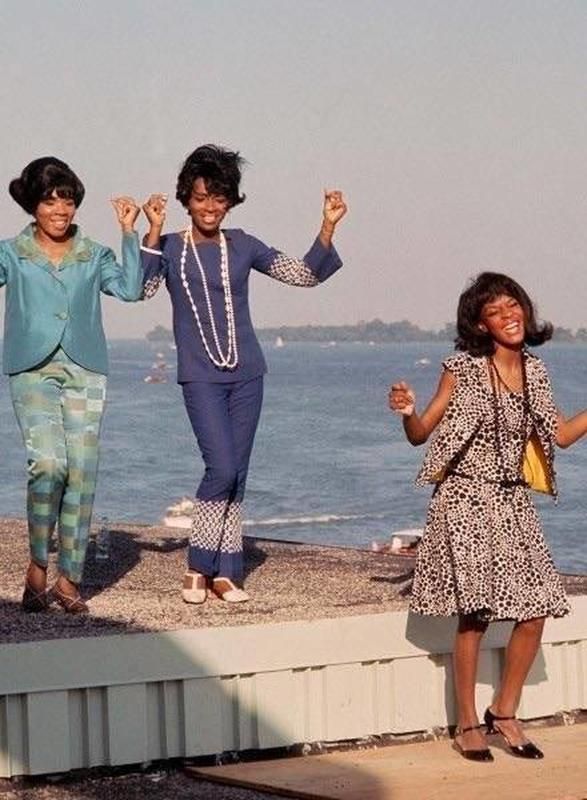How to make the spinning dancer change direction
The Spinning Dancer Illusion Explained
This popular illusion created by Nobuyuki Kayahara in 2003, shows the spinning silhouette of a female dancer. If the viewer’s perception is that the foot touching the floor is the left foot, then the dancer appears to be spinning in a clockwise direction. If the foot touching the floor is perceived to be the right foot, then the dancer seems to be spinning in a counterclockwise direction. However, it is possible for the same viewer to see the dancer spinning in BOTH clockwise and counterclockwise directions. The change in direction can sometimes be observed after blinking or by focusing on a specific part of the image.
After conducting an online survey, Munger (2008) reports on a puzzling find:
While the illusion can’t actually determine whether you’re “right-brained” or “left-brained,” we were curious about what actually affects people’s perception of the illusion. Over 1,600 readers took our online survey about the illusion.
What’s interesting about the illusion is that it’s ambiguous — it can appear to be spinning both clockwise and counter-clockwise… roughly two-thirds of viewers initially saw it spinning clockwise, while a third saw it spinning counter-clockwise. About two thirds of viewers were able to reverse the direction of rotation from clockwise to counter-clockwise or vice-versa. Interestingly, this ability was affected by the initial direction of motion…If you saw the figure spinning counter-clockwise first, then you were significantly more likely to be able to reverse the direction of rotation than if you saw it spinning clockwise first. This makes some sense, since more people see it rotating clockwise — it may be that there’s a natural tendency to see it spinning that way, which means it’s more difficult to reverse from clockwise to counter-clockwise than the other way around.
How is it even possible for us to see a single image rotating in opposite directions? Well, due to the image’s lack of visual cues for depth, the ambiguous 2-dimensional figure can be seen from two different perspectives.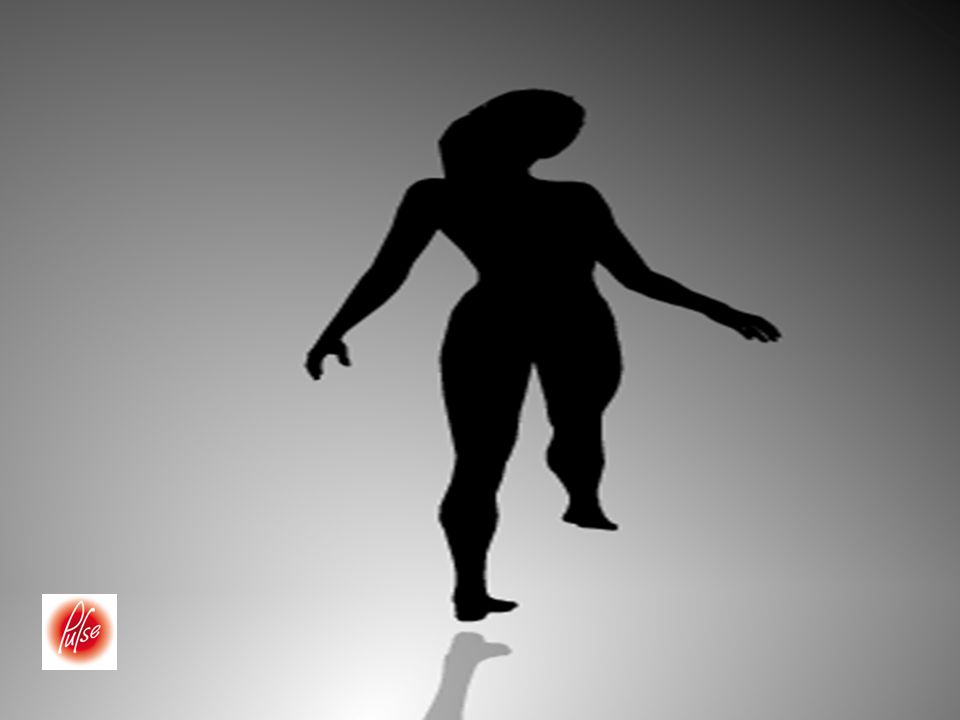 This alternation between two perceptual states is referred to as bistable perception. The illusion’s inherent visual ambiguity presents our visual systems with two different interpretations of the same stimulus, as opposed to the one unique interpretation we are more accustomed to in everyday life. By using simple techniques such as blinking rapidly, narrowing visual focus or even tilting our head, we might be able to switch from one perspective to the other.
This alternation between two perceptual states is referred to as bistable perception. The illusion’s inherent visual ambiguity presents our visual systems with two different interpretations of the same stimulus, as opposed to the one unique interpretation we are more accustomed to in everyday life. By using simple techniques such as blinking rapidly, narrowing visual focus or even tilting our head, we might be able to switch from one perspective to the other.
Reference
Munger, D. (2008). Casual fridays: Tk-421, why can’t you spin that woman in reverse? Cognitive Daily. Retrieved on April 25, 2012 from http://scienceblogs.com/cognitivedaily/2008/10/casual_fridays_tk421_why_cant.php
This entry was posted in Cognitive Psychology, Fun Facts And Optical Illusions and tagged bistable perception, perception, silhouette illusion, spinning dancer, visual ambiguity on by WIP.How Does The "Spinning Dancer" Optical Illusion Work? This Brain Trick Will Make You Dizzy
Life
by Lily Feinn
Sergei Savostyanov/TASS/Getty Images
As a kid, I stacked my bookshelf high with Magic Eye books and littered the pages of my journals with sketches of the Necker cube. As such, it should come as no surprise that I have wasted a fair amount of time today pondering how the "spinning dancer" optical illusion works. Web designer Nobuyuki Kayahara’s image of a silhouetted female dancer pirouetting has been around since 2003, but the optical illusion hasn’t become any less infuriating over time — so I decided to do a deep-ish dive into its inner workings. Now seems like as good a time as any, right?
The animation was originally shared as a supposed test of left or right brain dominance. Those who see the dancer spinning clockwise were supposedly utilizing their right brain, and hence were said to be more creative and artistic, while those who interpreted the dancer as spinning counterclockwise were allegedly more in-tune with their left brain, and therefore more logical. As I stared at the screen for minutes on end, the dancer appeared to be moving clockwise, and I patted myself on the back for being so darn creative. My momentary joy was squashed, however, when I learned that the image is actually test of our vision, not our brain power; it turns out that all that left-brain right-brain stuff is oversimplified nonsense. Sigh. Why can’t it be just that easy?
As I stared at the screen for minutes on end, the dancer appeared to be moving clockwise, and I patted myself on the back for being so darn creative. My momentary joy was squashed, however, when I learned that the image is actually test of our vision, not our brain power; it turns out that all that left-brain right-brain stuff is oversimplified nonsense. Sigh. Why can’t it be just that easy?
The spinning dancer is what is known as a reversible image. The ambiguous silhouette contains no depth cues, so some people may interpret the image as a dancer standing on her right leg spinning to the left, while others will see her standing on her left leg spinning to the right. Upon first viewing, most people see the dancer as spinning clockwise; however, stare at the animation long enough you'll see the image reverse (and get pretty dizzy in the process). It's similar to the oldest and most famous reversible illusions, the aforementioned Necker cube; the ambiguous line drawing of a wire cube can be interpreted several ways, with the face of the cube shifting locations.
What makes both illusions so tricky is a lack of depth clues, leaving your brain to fill in the gaps. Your brain hates ambiguity, so it tries to solve the image quickly by imposing meaning onto it. When the dancer is given some definition, it becomes abundantly clear which way she is spinning:
To get a better sense of the direction in which the dancer spins without the helpful contouring, focus primarily on the foot she is standing on, and the shadow beneath her. "If you want her to switch directions, look at her as if you're filming her from below. Now pretend to be filming her from above," advises Arthur Shapiro, author of The Oxford Compendium of Visual Illusions, according to Vice's Tonic site. If you view the image as if from above, the dancer will appear to be spinning clockwise; however, she'll reverse her direction if you imagine yourself looking up at the dancer. Most people view these ambiguous illusions as if they are looking downward, due to the evolutionary part of our brain that deals with fear and threats: The subcortical system.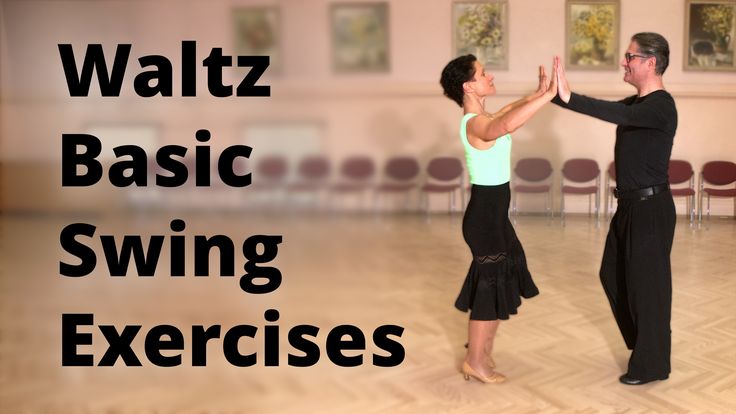 Our brain is used to looking down for dangers that may lay on the ground, so we view the image as spinning clockwise. Neat, huh?
Our brain is used to looking down for dangers that may lay on the ground, so we view the image as spinning clockwise. Neat, huh?
Well, even though this image has nothing to do with brain hemispheres and creativity, I'm still gonna use my pottery class Groupon. Embracing your creative side is good for you, right?
Images: Sergei Savostyanov/TASS/Getty Images; Giphy (2)
Rotation of the girl around its axis. In which direction is the girl spinning? Test. Or is it an optical illusion.
The picture of the girl you see now was created by Japanese designer nobuyuki kayahara and made the rounds on the internet a year ago as a test of which part of your brain works best. If, for example, you saw a girl spinning clockwise, it was assumed that you had a more developed right brain, and if a girl was spinning counterclockwise, it was assumed that you had a more developed left brain.
It is interesting that until a few decades ago, the right hemisphere of the brain was not given much importance, believing that it was in some way meaningless. Only later, scientists came to the conclusion that the right hemisphere is infinitely important for the development of a creative personality.
Only later, scientists came to the conclusion that the right hemisphere is infinitely important for the development of a creative personality.
Reference:
Left hemisphere
Verbal information processing:
The left hemisphere of the brain is responsible for your language abilities. This hemisphere controls speech and the ability to read and write. It also remembers facts, names, dates and their spelling.
Analytical thinking:
The left hemisphere is responsible for logic and analysis. It analyzes all the facts. Numbers and mathematical symbols are also recognized by the left hemisphere.
Sequential information processing:
Information is processed by the left hemisphere sequentially in stages.
Right hemisphere
Processing of non-verbal information:
The right hemisphere specializes in processing information, which is expressed not in words, but in symbols and images.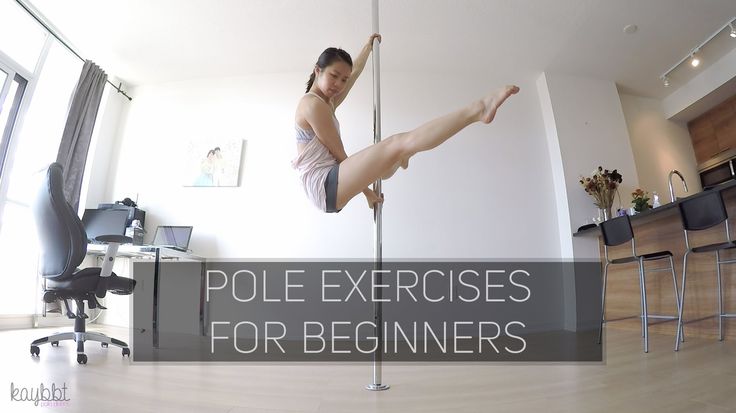
Imagination:
The right hemisphere enables us to dream and fantasize. With the help of the right hemisphere, we can make up different stories. The right hemisphere is also responsible for the ability to music and visual arts.
Parallel information processing:
The right hemisphere can simultaneously process a lot of different information. It is able to consider the problem as a whole without applying analysis.
Most people will see that the dancer is spinning counterclockwise, so they use the left side of the brain more, but if you focus, you can change the direction of the dancer's rotation. Personally, I manage to change the direction of rotation without much effort, I see that the dancer rotates clockwise and for a while, by concentrating, I can maintain a different direction of rotation. Try it too!
According to Yale University, where the human brain and its functioning have been studied for 5 years, those who can switch the direction of a girl's rotation without straining their eyes too much have an iq above 160.
Or is it just an optical illusion? In which direction is your girl spinning? Is it possible to change direction?
TEST FOR DOMINANT DEVELOPMENT OF THE LEFT OR RIGHT HEMISPHERE
Look closely at this girl. Which way do you think it's spinning?
If you see that in a clockwise direction, your left hemisphere is better developed.
It is responsible for abstract-logical thinking. You have good analytical skills, as well as the ability to foreign languages, remember numbers and dates perfectly, and are friendly with mathematics.
If it seems to you that the girl is spinning counterclockwise, your right hemisphere is better developed,
Which is responsible for figurative-spatial thinking. You have a wonderful intuition, you feel people well, understand their emotional state. You are the owner of a rich imagination. Ability to music or painting is very possible.
Imagine a girl standing on her left leg with her right leg raised. Now try to imagine the opposite - the girl is standing on her right leg, the left one is raised. This image is unusual in that both options can be represented. A kind of optical illusion is created. At the time when the images begin to change in the animation, the direction of rotation of the girl you see will depend on which leg you consider her standing on - on the right or left. Thus, you can understand which hemisphere of your brain is better developed.
Now try to imagine the opposite - the girl is standing on her right leg, the left one is raised. This image is unusual in that both options can be represented. A kind of optical illusion is created. At the time when the images begin to change in the animation, the direction of rotation of the girl you see will depend on which leg you consider her standing on - on the right or left. Thus, you can understand which hemisphere of your brain is better developed.
It is even more interesting to watch together - the vision will be different, and you will be able to compare the results and draw conclusions.
You see this test thanks to Konstantin . Be sure to visit his website - you will see such exciting videos and materials that you probably have not seen before. Once you've been there, you just can't help but come back!
Enjoy watching!
This illusion is ancient and known, almost like the Internet itself - back in 2003, the Japanese designer Nobuyuki Kayahara - Nobuyuki Kayahara - proposed an interesting GIF: Silhouette Illusion "Illusory Silhouette", which was 34 looped frames.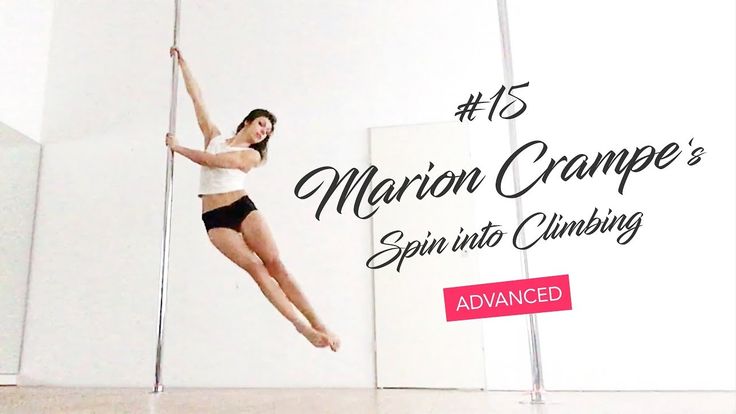 In Runet, she was simply called "The Spinning Girl".
In Runet, she was simply called "The Spinning Girl".
And despite the fact that she is over 12 years old, I was surprised that there are people who have not yet heard of this illusion. Well, if so, then you can tell, but for those who know, but cannot force it to rotate in the other direction with the power of thought, help to do it.
First of all, the illusion itself. Look and tell me - does it rotate clockwise on the left foot, or counterclockwise on the right?
They say that those who see clockwise rotation have a more developed left hemisphere (logic, analysis), counterclockwise - the right hemisphere (emotions, intuition). This statement is controversial, but we will not go into it deeply, because it is unprovable. As well as the fact that those whose girl rarely changes the direction of movement (or does not change at all) are people of a more practical, rational warehouse, and those whose girl often changes the direction of rotation are persons with a richer imagination, not always consistent.
Much more interesting is how this illusion is made, and how to see the rotation of the girl in the opposite direction with the power of thought.
The main idea of the video is to take shots on which it is impossible to determine which leg is the supporting leg - left or right, and which is in front and which is behind. In a flat picture, there are only two dimensions, and the end of the girl's foot does not actually describe circles, but moves alternately back and forth along the horizontal axis; we add a third dimension from ourselves to the image - depth, doing it in one of two possible ways. The direction of rotation depends on how exactly we do this. Thus, it's all about the interpretation of "where is the left and where is the right foot", carried out by the human pattern recognition system. Since the same images on the frames can be taken both as standing on the right and as standing on the left foot, everything is at the mercy of the imagination.
If the imagination perceives the left leg as the supporting leg, then the figure rotates clockwise, but if the supporting leg is interpreted as the right leg, then counterclockwise.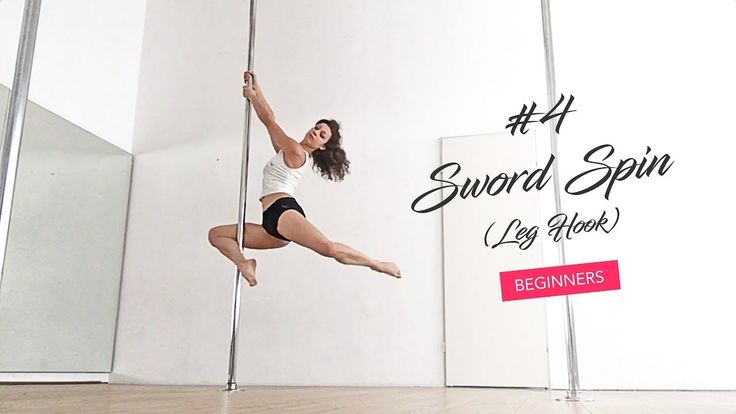 While watching the video, the phenomenon of changing the perception of the supporting leg arises - it suddenly changes involuntarily (and maybe arbitrarily) - then the girl begins to rotate in the other direction. Same thing with the head.
While watching the video, the phenomenon of changing the perception of the supporting leg arises - it suddenly changes involuntarily (and maybe arbitrarily) - then the girl begins to rotate in the other direction. Same thing with the head.
Be honest - how long did it take you to spin the girl in both directions? In order not to scroll up, I will give the gif again:
If it didn’t work out for at least a few minutes - I’ll give you a hint - try scrolling the picture so that only the shadow and the edge of the foot remain, and again try to mentally change the direction of rotation, imagining first that the shadow of the rotating leg passes in front of the supporting leg, and then for her. After you managed to spin the shadow in the right direction, slowly lower the entire picture back, following up from the shadow.
Well, how did it work out?
Well, if not again, then don't be upset. Under the spoiler is a picture that will definitely make you understand the principle of what is happening, and how to make yourself think that it can spin in any direction that we want 🙂 Well, of course, it’s better to click on the picture to open it in full .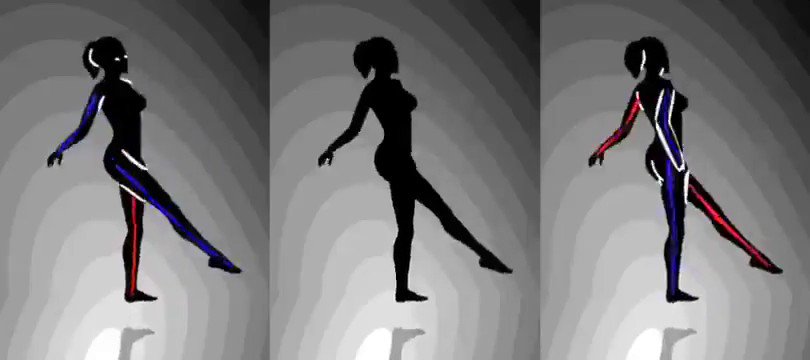
Now it's not difficult, is it?
And finally, another interesting three-dimensional illusion in two-dimensional form, from those that Maurits Cornelis Escher still painted, (one of the first and most famous engravings - Belvedere):
They are already wonderful in themselves, but even more interesting — see them in motion!
Well, in 1958 Escher was impressed by an article on impossible figures by the physicist and mathematician Roger Penrose, published in the British Journal of Psychology. Including the famous "Penrose Triangle" (which was actually discovered back in 1934 by the Swedish artist Oscar Reutersvärd). This impossible triangle is easiest to represent using twelve dice (cubes):
It is clear that it is impossible to build such a triangle in three-dimensional space. But in 2D, why not? Moreover, let's try to roll a ball along such a triangle. Look - on what plane will it move?
Spinning ballerina test. We expose! In which direction is the train going and where is the dancer spinning? Trainer-exercise to expand the capabilities of your brain
Visual test by Vladimir Pygach to determine the dominant hemisphere of the brain. This is really a fundamentally new psychophysiological test. This test helps determine which side of your brain is more active. The test shows your current state . And in some cases, you will be able to observe the moment of switching the hemispheres of your brain
This is really a fundamentally new psychophysiological test. This test helps determine which side of your brain is more active. The test shows your current state . And in some cases, you will be able to observe the moment of switching the hemispheres of your brain
And yet, it is not only and not so much a picture that rotates in one direction or another, but a perceptual image of a moving space formed by your brain. In short, the girl actually revolves in your perception.
You determine the strengths of your brain.
Especially for ambidexters (lat. ambi - double; dextrum - right). That is, people who simultaneously have right hemisphere and left hemisphere asymmetry, dominance in the work of the brain. In recent years, according to our data, a significant number of ambidexters have been found among children with ADHD (37.95% on average), see the article Functional brain asymmetry in children A among children with autism spectrum disorders (ASD) - more than 76%.
Ambidextrous is a special group of people with abilities well above the norm. Suffice it to say that there are many such people with a special organization of the brain among the seids - direct descendants of the Prophet Muhammad, among the Levites and Kohanim , and other prominent people. For example, Benjamin Franklin (who is featured on the $100 bill), Vladimir Putin, US President Barack Obama, sheikhs in the United Arab Emirates are all ambidexters. That is, people with potentially unique abilities that may or may not be realized.
If you got into this company - congratulations :-))
Please take this test as seriously as possible. It can be repeated from time to time. I do it myself. With the dominance of the left hemisphere, the "logicians" girl rotates to the right. With the dominance of the right hemisphere, in "artistic eidetics" the girl suddenly begins to rotate to the left. In ambidexters - when the head is tilted in the appropriate direction - then to the right, then to the left!
Introduction
This test shows your state and features of perception of moving perceptual (subjective) spaces that your brain processes and "sees" at the moment . This is especially true for ambidexters (lat. ambi - double; dextrum - right). That is, people who simultaneously have the right hemisphere and left hemisphere of the brain.
This is especially true for ambidexters (lat. ambi - double; dextrum - right). That is, people who simultaneously have the right hemisphere and left hemisphere of the brain.
Ambidextrous and "two-armed", these are not the same thing, although they are close concepts.
People can be right-handed or left-handed
- by eye movements (reflect the work of the brain),
- on the dominant eye (when shooting, for example),
- as well as through the auditory channel (to which ear the handset is placed),
- by hand (hold pen, knife, screwdriver, needle while sewing),
- on the leg (pushing leg, hitting the ball),
- rotation of the axis of the heart on the electrocardiogram, etc.
So most likely you are a combination of these individual communication channels...
And also note that, as a rule, specialists use a group of tests for any psychological diagnosis. For example, we duplicate the study of asymmetry features on Yu. A. Tsagarelli, as well as classical tests for "right-handedness and left-handedness", etc.
A. Tsagarelli, as well as classical tests for "right-handedness and left-handedness", etc.
Testing
Make yourself comfortable.
So, in the picture you see the silhouette of a rotating figure.
1st stage. Psychological setting
The psychological tuning of your brain lasts approximately 2 minutes.
2nd stage. Actually testing
- If the figure steadily rotates only clockwise, it means that the left hemisphere dominates in you, the left hemisphere activity of the brain prevails. And this is logic, counting, the ability to speak and express thoughts.
- Rotation only counterclockwise means that the right hemisphere dominates in you, and predominantly right hemisphere activity prevails - eidetics, intuition, imaginative thinking, musicality, a sense of orientation in space and time.
- If the figure alternately rotates either in one or the other direction, this is a sign of ambidexterity, that is, the work of both the right and left hemispheres of the brain alternately.

For some, this switch of rotation of the silhouette occurs when the head is tilted to the right, then to the left, and vice versa.
For others, a change in the direction of rotation is noted when the gaze is focused on the face, then it is defocused, and vice versa.
Or alternatively, shifting the gaze approximately 15 degrees. left-down - rotates to the left. Translation of the gaze to 15 degrees. right-down - rotates to the right. (addition of the site visitor Stas Redrugin)
Sometimes - it is useful to cover the lower part of the torso of a spinning girl with your hand - it works better.
Thus, we offer a game test for right-left hemisphere, which is convenient when working with children.
For clarity, the diagram of the brain :[cit. according to ROOOIVS "Rusichi"]
By the way, you can also test using mobile communicators
Training activates and balances the work of the right and left hemispheres of the brain.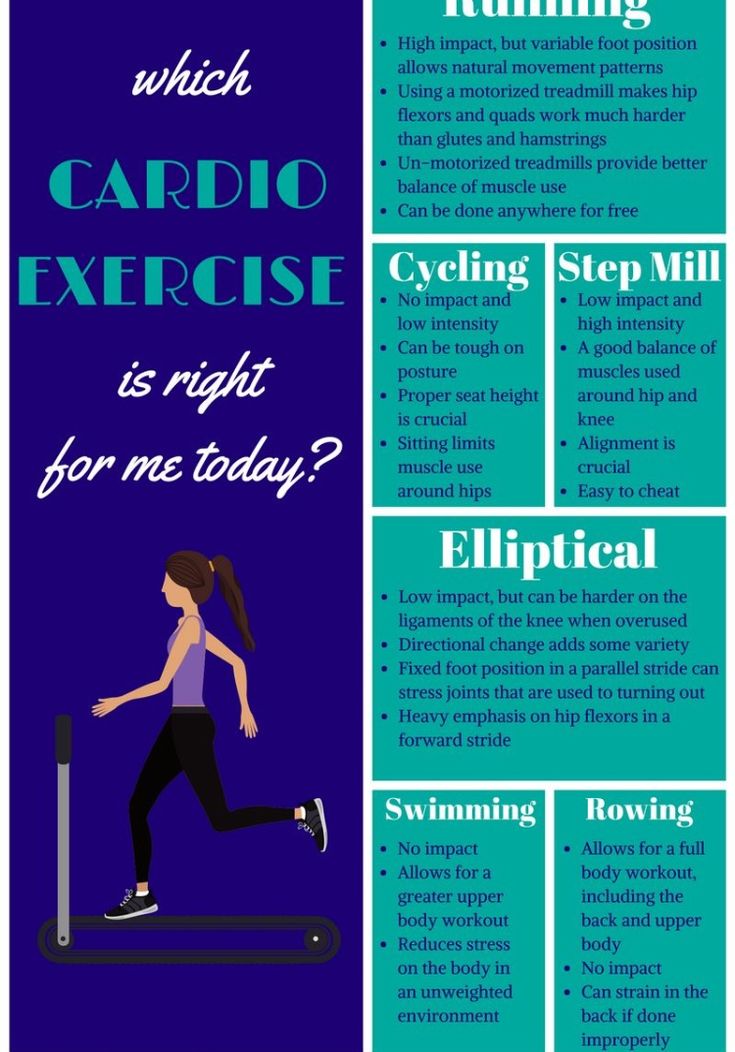 At some point, the girl begins to rotate in different directions. This is the level of informational metabolism of your brain.
At some point, the girl begins to rotate in different directions. This is the level of informational metabolism of your brain.
Look carefully for about 2 minutes, and then tilt your head (or otherwise) try to control the rotations in different windows in a new way.
Pay attention to the fact that in a few days each repetition of the training will give NEW sensations and results. For example, if the picture is above eye level. Below eye level. What's the Difference.
THIS IS A POWERFUL TRAINER FOR DEVELOPING AND "TURNING ON" YOUR BRAIN
You determine the strengths of your brain.
Especially for ambidexters (lat. ambi - double; dextrum - right). That is, people who simultaneously have right hemisphere and left hemisphere asymmetry, dominance in the work of the brain.
Ambidextrous is a special group of people with abilities well above the norm. Suffice it to say that such people with a special organization of the brain are among the most prominent people.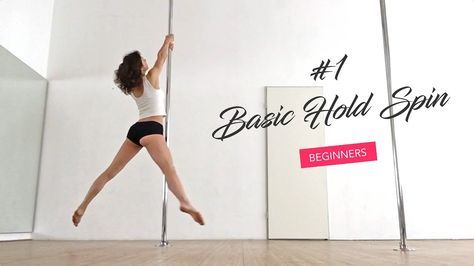 For example, Benjamin Franklin (who is featured on the $100 bill), US President Barack Obama, sheikhs in the United Arab Emirates are all ambidexters. That is, people with potentially unique abilities that may or may not be realized.
For example, Benjamin Franklin (who is featured on the $100 bill), US President Barack Obama, sheikhs in the United Arab Emirates are all ambidexters. That is, people with potentially unique abilities that may or may not be realized.
Please take this test as seriously as possible. It can be repeated from time to time. With the dominance of the left hemisphere, the "logicians" girl rotates to the right. With the dominance of the right hemisphere, in "artistic eidetics" the girl suddenly begins to rotate to the left. In ambidexters - when the head is tilted in the appropriate direction - then to the right, then to the left!
"The brain is 78% water, 15% fat, and the rest is proteins, potassium hydrate and salt. There is nothing more complex in the universe that we know that is comparable to the brain in general."
Tatyana Chernigovskaya.
Hello dears.
Let's mercilessly expose one of the most popular myths about the brain of recent decades.
"The left hemisphere of the brain is responsible for the work of logic, and the right hemisphere is responsible for creativity" - familiar phrase?
So…
This hemispheric theory about the functional asymmetry of the cerebral hemispheres is one of the most popular myths about the human brain.
However, the coolest myth about the brain is that humans only use 10% of the brain.
But about this Myth another time.
Together with the myth about "hemisphericity" the myth about the "necessity of synchronization" or "balancing" of the cerebral hemispheres was born. Synchronization at the request of the owner is also a myth. The theory that left-handers are more creative than right-handers and right-handers are more logical than left-handers is also a myth. And now only the lazy and living on a desert island have not heard about this theory of "hemisphericity" and "synchronization of the hemispheres."
The Internet and TV are filled with videos and articles on this topic. How many trainings and books have already been written on this topic and included in the work on self-development, personal growth, and even psychology.
How many trainings and books have already been written on this topic and included in the work on self-development, personal growth, and even psychology.
Giant amount. It's amazing how this myth has captured humanity, sometimes professional psychologists with scientific degrees use it in their work. I won't name names now.
Why did the myth about the functional asymmetry of the cerebral hemispheres take root and gain popularity?
Because of its simplicity of explanation, this principle of the brain has gained popularity. It is very understandable from the standpoint of logic - if there are two halves, then they should differ in functionality.
Let's debunk the MYTH about hemisphere.
In reality, both hemispheres of the brain participate simultaneously in all processes of our activity, communicating with each other. The myth was born after a false interpretation of Roger Sperry's research on curing people with epilepsy by cutting the corpus callosum. In the course of the study, it was found out which of the hemispheres adapted better after separation to one or another form of activity. But this does not mean that a healthy person's brain works in a similar way. For the healthy functioning of the human body and psyche, it is necessary to activate and engage different parts of the brain.
In the course of the study, it was found out which of the hemispheres adapted better after separation to one or another form of activity. But this does not mean that a healthy person's brain works in a similar way. For the healthy functioning of the human body and psyche, it is necessary to activate and engage different parts of the brain.
The interaction of the hemispheres is already harmoniously synchronized by nature. If this natural synchronization is disturbed, then problems begin. Nature is smarter than us, everything has already been invented before us by evolution and by nature itself - the creator.
And now the Test with the Ballerina (see the video for the post).
Its rotation determines not the work of the right or left hemisphere, but the flexibility and variability of thinking, the ability to think in different directions, not to go in cycles in stereotypes.
The ballerina rotates in the direction in which you, your brain, consciousness admit that she can rotate, i. e., based on your usual picture of the world, beliefs and beliefs, the ballerina rotates clockwise or counterclockwise. More often people see rotation clockwise, less often counterclockwise. This is due to stereotyped thinking. If a person survives the experience of counterclockwise rotation of a ballerina, then he will already be able to consciously change the direction of her rotation at will.
e., based on your usual picture of the world, beliefs and beliefs, the ballerina rotates clockwise or counterclockwise. More often people see rotation clockwise, less often counterclockwise. This is due to stereotyped thinking. If a person survives the experience of counterclockwise rotation of a ballerina, then he will already be able to consciously change the direction of her rotation at will.
The stereotype (script) of thinking has changed through experience. (This is what a psychologist does in a consultation.)
In a state of relaxation, the brain can make assumptions that the Ballerina can rotate counterclockwise. After the experience, there is a chance to deploy the Ballerina. (This is why it is important to be able to relax.)
All of the above applies to people who see only counterclockwise rotation. It is important to be able to see all positions and possibilities.
After watching the last frame of the video, you will be able to turn the Ballerina in different directions at will from any state, because you are convinced and gained experience that this is possible.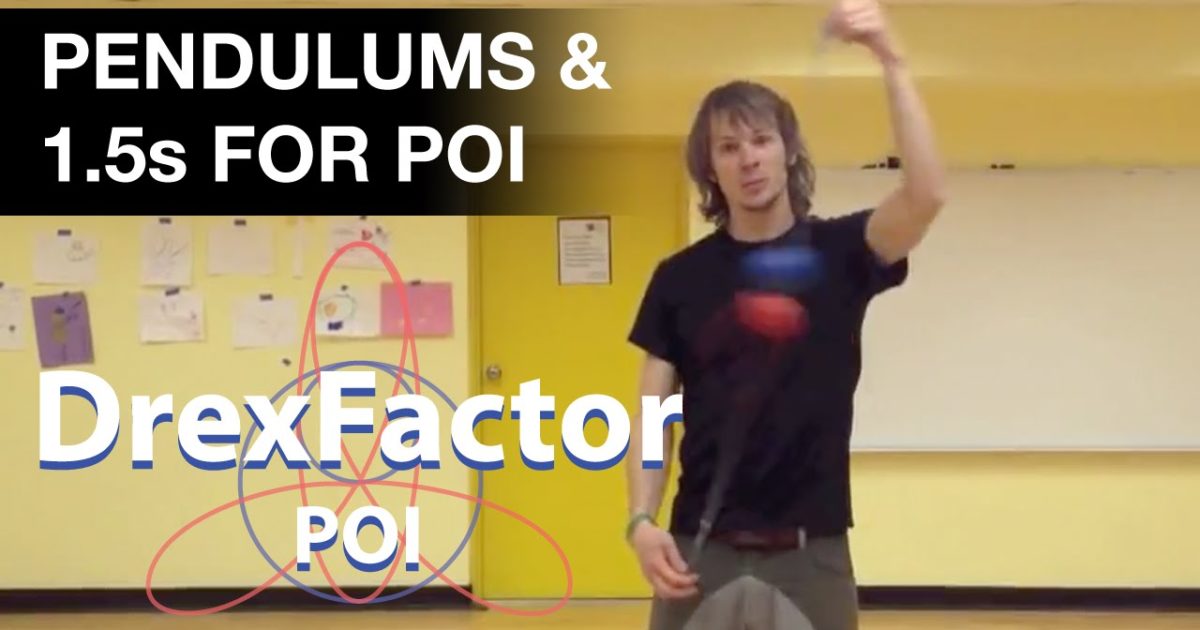
Interesting, did you like it, do you want more revelations?
Have a fruitful week.
Has everyone already seen this GIF? Pretty standard GIF (remember the spinning ballerina?). The only difference is that here we can find out exactly which way the train is going. Let's speak first:
Well, do you remember the classic example?
Here we will not find out with facts which way it is spinning, we will deal with this exposure a little later. But let's still get back to our train
Let's find out what versions of this situation are generally popular on the Internet:
1. They say that it depends on which hemisphere a person works more, the train moves in that direction.
2. There is a version that there are 2 frames there and 2 frames back, like it was specially made so that no one would guess. The GIF is looped 50% forward 50% back
3. And the reflection of the signal of the simophore or whatever it is? does it make sense for him to burn if he is coming out of the tunnel?
4. This is London, it seems, and there is left-hand traffic, which means it leaves.
This is London, it seems, and there is left-hand traffic, which means it leaves.
5. Thanks to my phone, which does not pull gifs well, it is clear that the train is entering the tunnel
6. It is going into the tunnel. The semaphore is reflected in the tunnel facing us, and hence the driver. PROFIT
7. all trains in the metro go to the left if you stand on the platform
8. It seems to me to Tunnel, and not from there, in the metro they seem to go on the right side)
9. it has doors on this side, so we
And here are the versions:
1. The train is coming out of the tunnel! For there is no clock, and the clock is ALWAYS located in the direction of the train.
2. And now let's think logically... Do you see the red color of the semaphore? This means that the train has already passed this place, after which the red lights up. By the way, you can see not the semaphore itself, but the reflection of light from it. It is also very easy to determine that the train is moving on your platform.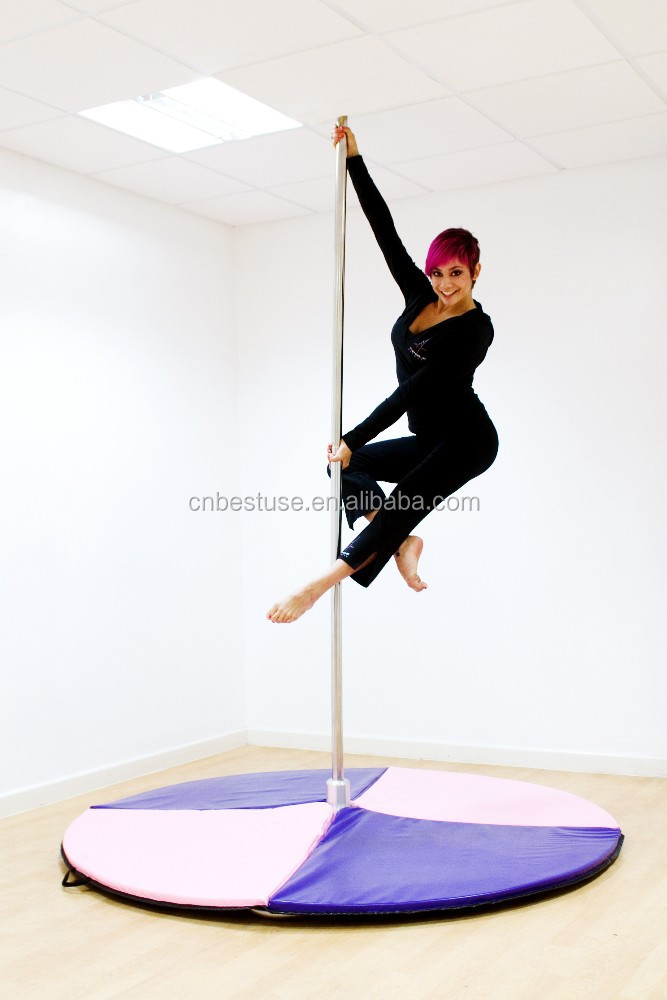 In the picture we see the end of the platform and, accordingly, the end of the train should stop there. Since at the beginning of the platform there should be mirrors or monitors for the driver, as well as a telephone for communication with the control center.
In the picture we see the end of the platform and, accordingly, the end of the train should stop there. Since at the beginning of the platform there should be mirrors or monitors for the driver, as well as a telephone for communication with the control center.
3. He is going to the camera. Because people are standing and waiting for him, and 1 carriage should have already stopped.
4. There is no dial, so it is entering)
5. If the train is leaving, why the hell are people standing and waiting?
6. people usually look in the direction from which the vehicle is approaching. The man just turned his head to the left.
7. There is a camera there, in order to take pictures of how many people are standing on the platform - like a rear-view mirror, which means there is no driver there, which means the train is coming towards us.
So where is he going then? Have you made a conclusion? Or still the only way to find out the truth is to wait for the last carriage.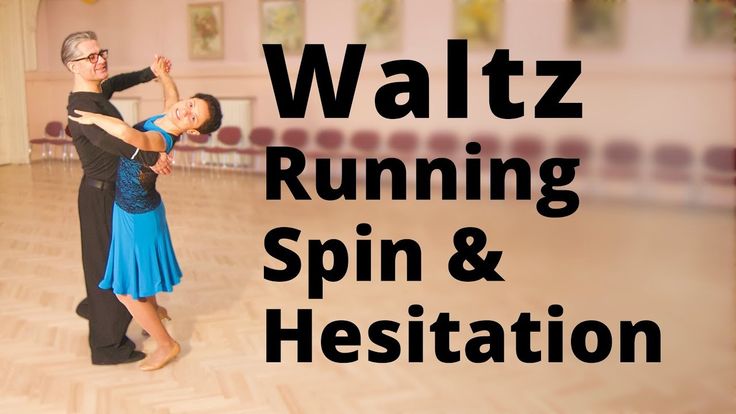 Let's get hints!
Let's get hints!
Let's slow down the GIF a bit:
If you look closely at the GIF, you can see the connection of trains (some people think that these are opening doors)
Well, this connection is approaching the camera, this is the only landmark by which you can determine the direction of movement. It turns out that the train leaves the tunnel.
Let's storyboard the GIF:
Clickable
And now let's give some reinforced concrete argument: The poster says Charing cross - this is a metro station in London.
It would seem that this is it! But I am tormented by vague doubts! It's not like the station recently had some kind of refurbishment. Pay attention to the floor in front of the tracks: there is no metal strip in the video, and the entrance to the tunnel without a grate at the top. There is no metal box in front of the tunnel.
and yet it's her.
, September 2011
And here is the black design on the top:
January 2011
Here is a video with these designs.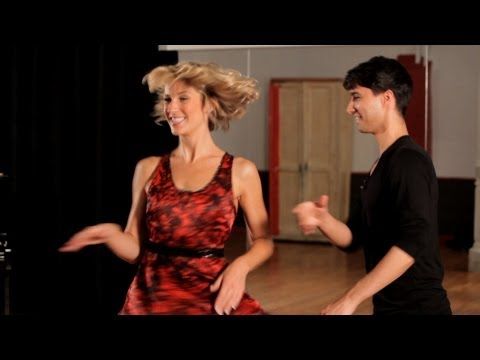
In general, 99% that the train is coming to us. Only the inhabitants of London can judge us. There are such? Please go to this station, see how it is there :-)
By the way, who is still tormented by the question about the ballerina, here you come across a clue along the way,
In fact, the picture is flat, and moves left and right, but our brain "twirls" her
The picture of a dancer was created by Japanese designer Nobuyuki Kayahara, and it has been all over the Internet as a supposed test of which part of your brain works best. If, for example, you saw a dancer spinning clockwise, it was assumed that you have a more developed right hemisphere of the brain (= you are left-handed, live intensively), and if the dancer was spinning counterclockwise, it was assumed that you had a more developed left hemisphere brain (you are right-handed, a more logical person).
Our visual system has evolved to create some kind of reasonable, familiar, mental image of the world from a limited amount of information, and thus using a huge number of different assumptions to form a complete image.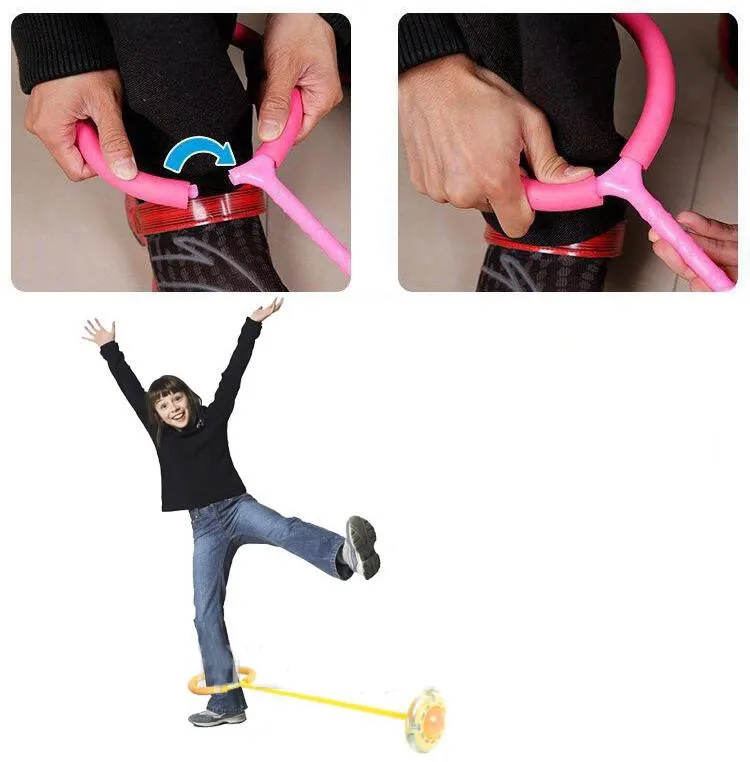 Usually these assumptions turn out to be sufficient and they can be interpreted in only one way, which is what our brain does. However, artists and scientists can use visual cues like this to trick our brains into interpreting what we see in different ways.
Usually these assumptions turn out to be sufficient and they can be interpreted in only one way, which is what our brain does. However, artists and scientists can use visual cues like this to trick our brains into interpreting what we see in different ways.
So, in this picture, your brain made up a dancer from funny black shapes, and then assumed that she rotated both clockwise and counterclockwise, and in turn “shows” one of the images, or even completely limited one, the most convenient and familiar. (Actually, the dancer moves her leg at a special angle, first in one direction, then in the other, in a flat, two-dimensional world). This is such an optical illusion.
The simplest test will help you check the functioning of your brain in a few seconds.
The picture of a spinning girl that you see all over the Internet has firmly won one of the leading positions as a test of which hemisphere of your brain works best.
When you look at the rotating silhouette of a ballerina, the direction of rotation "thinks out" our brain. It does not have any clear guidelines and a reference point, so some people see the rotation clockwise, others - counterclockwise.
It does not have any clear guidelines and a reference point, so some people see the rotation clockwise, others - counterclockwise.
Moreover, if you watch the rotation for some time, then at some point it may seem that the ballerina began to spin in the opposite direction. These are all tricks of our brain.
The left hemisphere processes verbal information. The left hemisphere is responsible for language abilities, controls speech, writing and reading abilities. Using the left hemisphere of the brain, a person remembers facts, dates, names and controls their writing. The left hemisphere of the brain analyzes all the facts, is responsible for analysis and logic. Mathematical symbols and numbers are also recognized by the left hemisphere. Information is processed sequentially.
The right hemisphere processes nonverbal information. The right hemisphere of the human brain processes information that is expressed not in words, but in images and symbols. Using the right hemisphere, a person is able to fantasize and dream, to compose stories.